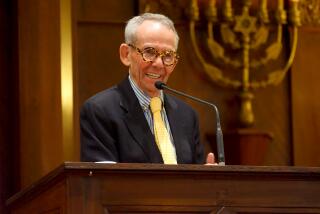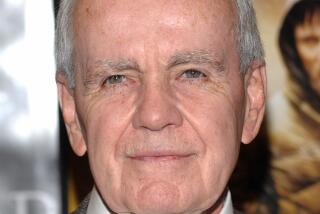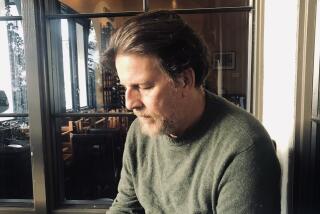From the Archives: Novelist Ernest Hemingway Dies of Gun Wounds
Sun Valley, Ida. — Ernest Hemingway, 61, the bearded American novelist who gained fame writing of death and violence, accidentally killed himself Sunday while cleaning a shotgun, his wife said.
Mrs. Hemingway, the “Miss Mary” who accompanied him on his world travels, was asleep upstairs. She was awakened by the shot, found the body and summoned a doctor to their home at Ketchum, near here.
Then she called Chuck Atkinson, a family friend, and asked him to put out a statement that the creator of “Farewell to Arms,” “The Old Man and the Sea” and “For Whom the Bell Tolls” was dead.
“Mr. Hemingway,” the statement said, “accidentally killed himself while cleaning a gun this morning at 7:30 a.m.”
No Inquest Scheduled
Atkinson said it was the statement Mrs. Hemingway wanted, that she feels the death was accidental. He said no note was found.
The county coroner, the sheriff and the prosecuting attorney talked for more than an hour and then decided not to call an inquest.
“I can only say at this stage that the wound was self inflicted,” said coroner Ray McGoldrick. “The wound was in the head. It could have been accidental or otherwise. There is no evidence of foul play, and no witnesses. Nothing could be gained by an inquest. But one could be called at any time if there was some reason to justify it.”
Found Near Gun Rack
Mrs. Hemingway found the body of her beloved “Papa” near a rack filled with the guns Hemingway loved to collect. Some friends said he had probably decided to do some hunting, but the general hunting season in Idaho is closed.
The barrel-chested writer was released from the Mayo Clinic at Rochester, Minn., last Monday, where he had been under treatment for hypertension, (high blood pressure). He and his wife came to their Idaho home by auto.
The noted writer originally entered the Mayo Clinic Nov. 30, 1960, and left there for his Idaho home last Jan. 23. But he returned to the clinic April 25. On May 31 a Mayo spokesman described a general improvement in the writer’s health.
The rugged Hemingway, a lover of the outdoors and sports, would have been 62 years of age on July 21.
There were reports that Hemingway had been in good spirits but that he had been saddened by the recent death of his good friend, actor Gary Cooper.
Atkinson, a Ketchum businessman and a personal friend of the novelist for 20 years, told reporters Mrs. Hemingway called him shortly after 7:30 a.m.
Wife Given Sedative
“I rushed over to the house and found Dr. Scott Erle there with Mrs. Hemingway,” Atkinson said. “But Hemingway apparently had died instantly.”
Atkinson was with Hemingway Saturday and said the author “seemed to be in good spirits.”
“We didn’t talk about anything in particular — just passed the time of day,” Atkinson recalled. “I think he spent last night at home.
“I took Mrs. Hemingway to the hospital, and they gave her a sedative to quiet her nerves. She seems to be all right, but asked me to get in touch with the family.”
Son Called Home
Atkinson reached Hemingway’s son Jack, who is on a fishing trip in Oregon, and said the son is coming here to take care of the arrangements.
He said another son is in Africa, a third in Florida, and a sister in Honolulu.
Coroner McGoldrick said he was called to the Hemingway home at 7:45 a.m. and returned the body to his mortuary in Ketchum.
“The funeral and burial will be Friday in Ketchum,” McGoldrick said. “This was Mr. Hemingway’s home; he loved it here. He was one of us and acted as a pallbearer for me a couple of times — once when one of his favorite guides passed away.”
Hemingway won world fame in 1929 with his novel “A Farewell to Arms,” which was based partly on his own experiences as an ambulance driver and soldier.
Then came a succession of novels. He was fascinated by bullfighters who died in the ring and his “Death in the Afternoon,” published in 1932, was a story of the bullring and the matadors.
The author himself once suffered several broken ribs while trying bullfighting. At the time he said he was “too old, too heavy and too awkward” for the sport.
Hemingway won the 1953 Pulitzer prize for fiction with his simple and compassionate story, “The Old Man and the Sea,” the story of an aged fisherman’s fight to land a giant catch.
Two Unpublished Novels
Hemingway won the Nobel Prize for literature in 1954 for his works in general. The citation, however, mentioned “The Old Man and the Sea.”
A source close to the Royal Swedish Academy of Literature made this prophetic remark on how the academy decided on Hemingway:
He was due to receive the award eventually and “we might as well give it to him now before he kills himself” in some adventure.
(Two Hemingway novels remain to be published. One, “The Dangerous Summer,” was serialized in an abridged version by Life Magazine last year and is scheduled to be brought out by Scribners. Friends said he had recently completed another novel but its title and subject has never been divulged.)
Other books that brought fame to Hemingway included “For Whom the Bell Tolls,” and “Across the River and into the Trees.”
Just as the characters in his fiction, Hemingway’s life was filled with excitement and narrow escapes.
During an East African safari in 1954 he was in two plane crashes on successive days. He escaped with minor injuries in both.
Son of Physician
From such varied experiences came the material for his lusty writing. He wrote his flavorful prose style in a model that scores of writers followed. His admonition to would-be writers: “Nobody but fools ever thought it was an easy trade.”
He was the son of Dr. Clarence E. Hemingway, a physician, and the former Grace Hall, concert singer. Dr. Hemingway practiced in Oak Park, Ill. He was found shot to death in the bedroom of his home in 1928. The mother died in 1951.
After graduation from high school Hemingway became a cub reporter on the Kansas City Star but he soon left to join an American ambulance unit headed for the Italian front in World War I.
Later he joined an Italian infantry regiment and was wounded and twice decorated.
He also went as a reporter to the Spanish Civil War and World War II.
The novelist, a man of six feet and about 200 pounds, was married four times and had the three sons by his first two marriages.
The woman who was widowed by his death, the former Miss Mary Welsh, also a writer, married Hemingway in 1946. They traveled the world together. He called her Miss Mary and she called him Papa.
Lived in Cuba
His first three marriages were to Hadley Richardson in 1921, Pauline Pfeiffer in 1927 and Martha Gellhorn in 1940. They ended in divorce.
Hemingway and Mary made their home on a farm in Cuba about 10 miles from Havana for several years.
A reporter who visited his home there in 1950 said the author’s writing day ran dawn until just past noon.
Hemingway’s literary career began in Pairs. He did sideline writing for periodicals while serving as corespondent for the Toronto Star. There were collected in 1923 for his first book, “Three Stories and Ten Poems.”
Other Works
His other works include: “In Our Time” (1924), “The Torrents of Spring” (1926), “The Sun Also Rises” (1926), “Men Without Women” (1927), “Winner Take Nothing” (1933), and “To Have and Have Not” (1937).
Several of Heminway’s most successful novels were made into motion pictures, including “Farewell to Arms,” starring Rock Hudson and Jennifer Jones (1957), “The Sun Also Rises,” starring Tyrone Power and Ava Gardner (1957), and “The Old Man and the Sea,” starring Spencer Tracy (1958).
His “For Whom the Bell Tolls,” which was also made into a motion picture and received wide acclaim, won for Hemingway in 1941 a gold medal from the Limited Editions Club. The medal cited his work as the book published in the three previous years that was most likely to become a classic.
Former San Francisco Mayor Joseph Alioto Dies
John Wayne Dies at 72 of Cancer
Playwright August Wilson Distilled Black America
Ex-Chief Justice Rose Bird Dies of Cancer at 63
Jazz Great Duke Ellington Dies in New York Hospital at 75
More to Read
Start your day right
Sign up for Essential California for the L.A. Times biggest news, features and recommendations in your inbox six days a week.
You may occasionally receive promotional content from the Los Angeles Times.






